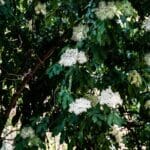It’s not only exotic plants from far-flung corners of the globe that make for beautiful and showy garden specimens. The shining fetterbush is a great native choice for natural gardens that requires very little upkeep if planted in the right area. Read on to learn more about this colorful evergreen shrub.
What Is Lyonia lucida?
Lyonia lucida, commonly known as the shining fetterbush, shiny leaf, fetterbush, fetterbush lyonia, hurrahbush, or Staggerbush is a 3-5ft tall evergreen shrub of the Ericaceae (heath) family.

This plant is native to the Southeastern coastal plain of the United States, from Louisiana in the west, throughout Florida, and to Virginia in the east, where it may occasionally reach heights of up to 13ft (4m). Fetterbush grows in the understory of shrubby bogs, wet savannas, cypress swamps, wet woods (wet pine flatwoods), peaty thickets, and stream banks.
These multi stemmed shrubs have beautiful leathery leaves that are glossy green. The simple leaves are alternately arranged and have smooth, entire margins.
Mature leaves measure 3-6 inches (7.5-15cm) long by 1-3 inches (2.5-7.5cm) wide. Each leaf has a major vein encircling it just inside the edge, and a prominent ridge appears along the bottom side of the leaf border.
Many plants of the genus Lyonia are known to be highly toxic to humans and animals if eaten, and some may cause irritation or rash if touched. L. lucida is not known to share these toxic qualities, although there are conflicting reports, and one should treat this plant with some respect to stay on the safe side. However, it attracts bees and other pollinators.
Over time, these plants will form colonies via root suckers and rhizomes.
Shining Fetterbush Flowers
Shining fetterbush flowers are usually pinkish but vary from white to red. The showy flowers are borne in bunches from the bases of leaves.
These fragrant, bell-shaped blooms are produced in axillary clusters of 10–15 in late winter to early spring and are regularly visited by bees and butterflies.
The small, ¼ inch (6mm) long flowers mature into 1/3 inch (8mm) long woody brown fruits.
How To Grow Lyonia lucida
Shining fetterbush can be grown from unprepared seed sown in early spring, cuttings, or root division. These plants can be grown in full sun, although they prefer full to partial shade or dappled light.
In the wild, this shrub thrives in bogs and swamps and tolerates soils that are periodically flooded and poorly drained. Still, when planted in homes, it appears to prefer acidic, moist soil with a pH below 6.8 and can be grown in poorly drained peaty soils with large amounts of organic material.
It is essential to maintain soil moisture levels to ensure the plant’s optimal growth and health.
It is a slow-growing evergreen shrub ideal for naturalizing in places with damp to seasonally wet soils. These sweetly fragrant flowers may not bloom in nutrient-poor soils to save energy. Should this be the case, a slow-release fertilizer may be helpful.
Care and Maintenance
This is not the easiest plant to keep in good health unless planted in a naturally seasonally moist area. Areas susceptible to seasonal flooding most closely mimic the conditions that this plant is adapted to grow in.
If planted in a suitable area, however, minimal maintenance is necessary. These bell shaped flowers can be cut back to the desired height when necessary.
Prune your fetter bush to encourage new growth and blooming, ideally in late spring or early summer. Focus on removing dead, diseased, or crossing branches to maintain air circulation and shape. Aim for light, thinning cuts on healthy stems to encourage bushier growth and vibrant blooms.
These shrubs are relatively disease-resistant but may be susceptible to plant problems such as leaf spot. If this is the case, focus on keeping the plant’s foliage dry, removing affected leaves and branches, and perhaps introducing a general-purpose fertilizer to improve the plant’s health before looking at more drastic measures like fungicides.
Uses
This plant’s suckering habits make it a good choice for shrub borders when planted in suitable conditions. Otherwise, this showy species is ideal for naturalized native gardens, especially in seasonally flooded areas where other plants cannot thrive.
FAQs
What are the leaves of fetterbush?
The leaves of fetterbush (Leucothoe spp.) are typically elliptical, leathery, and evergreen
How tall does a fetterbush get?
The height of a fetterbush can vary depending on the specific species and cultivar, but they generally range from 3 to 6 feet tall.
How many hours of sunlight does Fetterbush lyonia need?
Fetterbush (Lyonia spp.) typically thrives in full sunlight to part shade. It generally requires at least 4 to 6 hours of direct sunlight daily for optimal growth and health. And it takes less than 2 hours to get no direct sunlight for deep shade.
Conclusion
In conclusion, Lyonia lucida care is essential for maintaining the health and vibrancy of this unique plant. With its preference for acidic soils and tolerance for various light conditions, these pink flowers can be a versatile addition to your garden or landscape.
Embrace the beauty of Lyonia lucida in your outdoor space with the right care and appreciation for its natural characteristics.
See more: How to Care for Leucothoe fontanesiana






